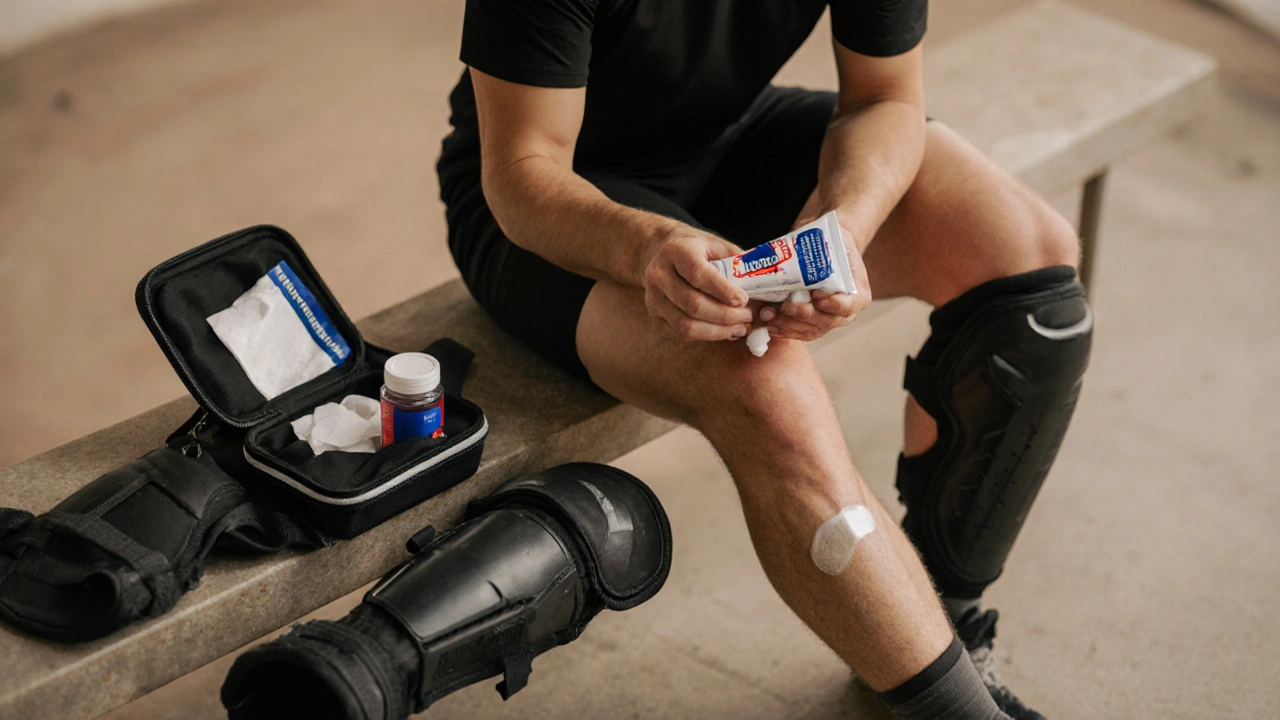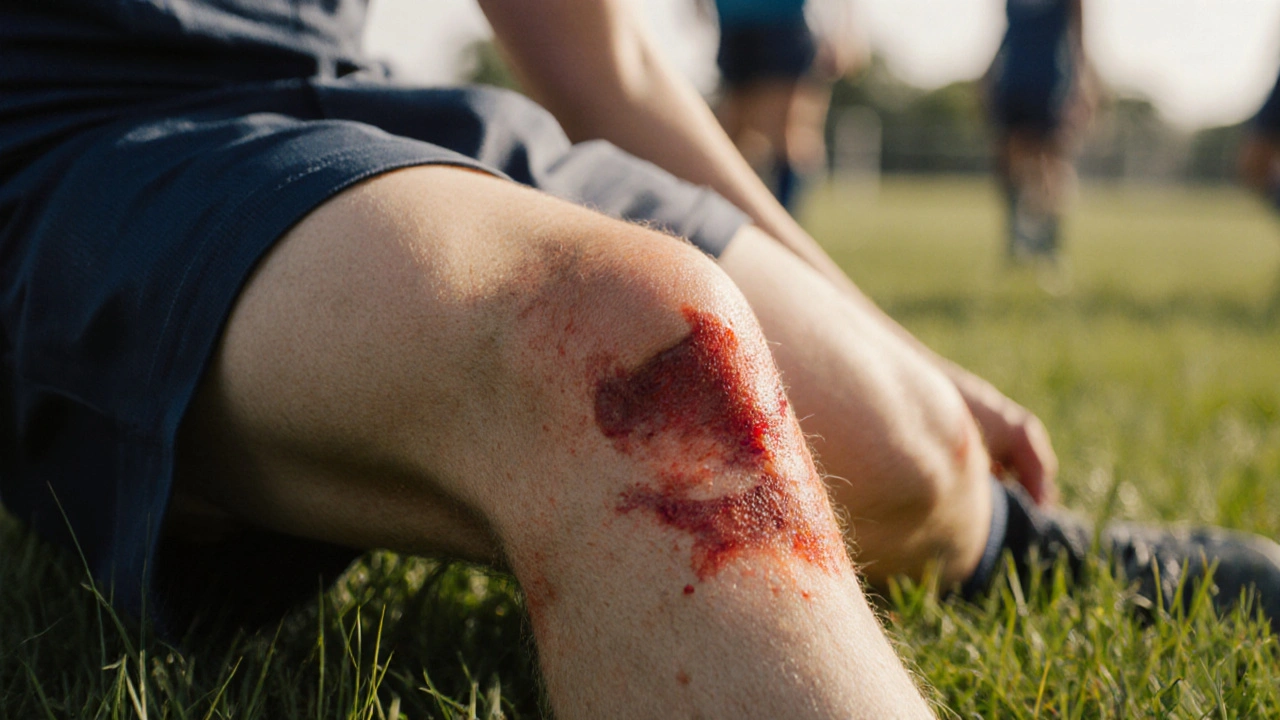Sports Abrasion Prevention Guide
Select Your Activity
Common Injuries
Prevention Tips
Top Prevention Tools
Best for: Soccer, Rugby, Skateboarding
Benefit: Absorbs impact, covers patella
Best for: Football, Hockey, Running
Benefit: Blocks direct hits, reduces friction
Best for: All contact sports
Benefit: Creates a slick surface, prevents skin tearing
Best for: First-aid kits
Benefit: Quickly disinfects fresh cuts
Best for: Everyday use
Benefit: Keeps skin flexible, reduces cracks
Best for: Any activity
Benefit: Essential supplies for immediate care
Ever walked off the field with a red, raw patch on your knee and wondered why it happened? You’re not alone. sports abrasions are the most frequent skin injuries in every game, from soccer to skateboarding. This guide shows exactly which scrapes show up most often, how to treat them right away, and the simple habits that keep them from happening again.
What is a sports abrasion?
When the outer layer of skin (the epidermis) is scraped off by friction, you get an abrasion. In sports, that friction comes from hard surfaces, rough turf, or equipment that rubs against the body. The wound is usually shallow, painful, and bleeds a little, but it can turn nasty if bacteria get in.
Abrasion is a superficial wound caused by scraping or rubbing the skin, often leaving raw, red tissue. While most heal in a week, the right care speeds recovery and avoids infection.
Top 5 abrasions you’ll see on the field
- Knee scrape - The go‑to injury for any sport that involves sliding or falling. Grass, dirt, and artificial turf all leave a tell‑tale stripe of red on the patella.
- Elbow nick - Common in basketball, volleyball, and gymnastics where athletes brace falls with their forearms.
- Shin abrasion - Runners, soccer players, and rugby participants often scrape the shinbone against the ground or goalposts.
- Hand palm scrape - Cyclists, climbers, and skateboarders get this when they instinctively slap the pavement.
- Hip graze - Less obvious but painful, especially for martial artists who roll onto hard mats.
Each of these wounds shares a simple pattern: friction, a thin layer of skin loss, and a need for clean, protected healing.
Why abrasions happen - the underlying causes
Understanding the why helps you block the how. Most sports abrasions stem from three factors:
- Surface roughness - Concrete, sand, and old turf create higher friction.
- Protective gear gaps - Badly fitting shin guards or missing knee pads leave skin exposed.
- Moisture imbalance - Dry skin cracks easily, while sweaty skin becomes slippery and slides off pads.
When any of these line up, the skin slides against a hard edge and you get an abrasion.

First‑aid steps for a fresh abrasion
- Stop the bleeding - Apply gentle pressure with a clean cloth for 1-2 minutes.
- Clean the wound - Rinse with lukewarm water or a saline solution. If dirt sticks, use a mild skin cleanser like diluted povidone‑iodine.
- Disinfect - Dab a thin layer of an antiseptic solution (e.g., chlorhexidine) to kill bacteria.
- Protect - Cover with a sterile adhesive bandage or non‑stick dressing. Change daily or if it gets wet.
- Watch for infection - Redness spreading beyond the edges, increasing pain, or pus means you need a sports medicine professional.
These steps take less than five minutes but drastically lower infection risk.
Prevention checklist - stop abrasions before they start
Think of prevention as a mini‑gear‑and‑routine audit. Tick each item before you head out.
- Inspect protective equipment - Ensure knee pads, shin guards, and wrist guards fit snugly without gaps.
- Apply a thin layer of skin barrier cream (e.g., petroleum‑jelly) on high‑risk areas if you’ll be sliding on rough surfaces.
- Keep skin moisturized - Use a fragrance‑free lotion after showers, especially in dry climates like Perth’s summer.
- Warm‑up properly - Dynamic stretches increase blood flow, making skin more supple and less prone to tearing.
- Choose the right playing surface - When possible, favor well‑maintained grass or synthetic turf over cracked concrete.
- Stay hydrated - Proper hydration maintains tissue elasticity, reducing skin cracking.
- Carry a small first‑aid kit - Include sterile gauze, antiseptic wipes, and adhesive bandages.
Gear and product roundup - what actually works?
| Tool | Best suited for | Key benefit | Typical price (AUD) |
|---|---|---|---|
| Knee pads | Soccer, Rugby, Skateboarding | Absorbs impact, covers patella | $45‑$120 |
| Shin guards | Football, Hockey, Running | Blocks direct hits, reduces friction | $30‑$90 |
| Petroleum jelly (Barrier cream) | All contact sports | Creates a slick surface, prevents skin tearing | $8‑$20 |
| Antiseptic wipes | First‑aid kits | Quickly disinfects fresh cuts | $12‑$25 (pack of 20) |
| Moisturizing lotion | Everyday use | Keeps skin flexible, reduces cracks | $10‑$35 |
Investing in the right gear doesn’t mean you’ll never get a scrape, but it cuts the odds dramatically.

When to see a medical professional
If after 48hours the abrasion hasn’t started to close, or you notice any of the following, book an appointment with a sports‑medicine clinician or a general practitioner:
- Increasing redness, swelling, or warmth around the wound.
- Yellowish discharge or pus.
- Severe pain that isn’t relieved by over‑the‑counter painkillers.
- Loss of sensation or tingling - could signal deeper tissue damage.
- Any sign of a puncture wound that could have introduced foreign material.
Early professional care can prevent chronic scarring and keep you in the game.
Quick‑reference cheat sheet
- Clean → Disinfect → Cover → Change daily.
- Wear fitted protective gear for the sport you play.
- Moisturize skin 2‑3 times a day, especially after showers.
- Keep a tiny first‑aid kit in your bag.
- Check equipment for cracks before each session.
Frequently Asked Questions
How long does a typical sports abrasion take to heal?
Most shallow abrasions close in 5‑7days if kept clean and covered. Deeper scrapes may need 10‑14days.
Can I use home remedies like honey or tea tree oil?
Honey has natural antibacterial properties and can be useful for minor cuts, but it isn’t a substitute for proper cleaning. Tea tree oil may irritate fresh skin. Stick to sterile antiseptic wipes first, then add a medical‑grade ointment if needed.
Is it okay to shave the area around an abrasion?
Avoid shaving until the wound fully heals. Cutting hairs can introduce bacteria and reopen the skin.
Do I need a tetanus shot after a sports scrape?
If you haven’t had a tetanus booster in the last 10years, or the wound was caused by a dirty object, get a shot. Most clean abrasions don’t require it.
Can I stay active while the abrasion is healing?
Yes, as long as the activity doesn’t put pressure or friction on the wound. Modify movements or use protective padding until the skin re‑epithelializes.


April Yslava
Ever notice how the sports gear industry pushes slick creams while they secretly hoard data on every scrape you get? They claim it’s for "performance" but the real agenda is to keep us dependent on their products. Dry skin is a symptom of a larger societal neglect, and the only cure they offer is a $20 tube of petroleum jelly. Keep your eyes open, because the next "innovation" will probably be a micro‑sensor that tells the government when you’ve been knocked down.